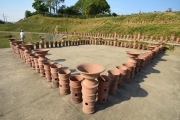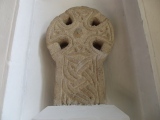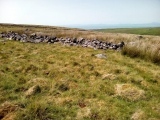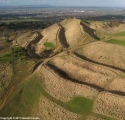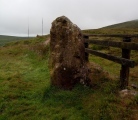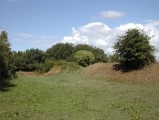Andy Burnham's Blog, page 193
July 5, 2020
IgenoYama Kofun
A keyhole-shaped tumulus, 128m long. Although the round part of the mound has been destroyed and modified into a modern graveyard, the rest of the tumulus was reconstructed in 2014 as a historic park with replica haniwa terracotta tubes. These were originally buried with the dead as funerary objects during the Kofun period, (3rd to 6th centuries CE)
Published on July 05, 2020 07:03
Sløsserup Langdysse
Langdysse (Long Barrow) in Maribo, Denmark with 19 large kerbstones. Overall size 12.5 x 11 x 2.5 meters. The chamber has five uprights and one huge capstone.
Published on July 05, 2020 06:36
Whissonsett wheel-head cross
Within St. Mary's church is the only complete top of a late Saxon wheel-head cross found thus far in Norfolk. It sits in a niche in the nave wall, on the south side of the chancel arch, and has been dated stylistically to the early 11th century. Part of the shaft has survived with it, 27cm wide, while the head is 43cm across. The overall height is 62cm, but was a little taller when first found. A broken bottom edge was chiselled off flat so that it could be displayed upright.
Published on July 05, 2020 06:14
July 2, 2020
Llyn Irddyn W
A 26m x 19m enclosure that possibly dates to the Iron Age although it may be later. Its outline is marked on the OS map.
Published on July 02, 2020 07:53
Doon Hill Dunbar
The site of a rectangular timber structure with massive posts which probably dates from the Neolithic period - possibly a hall but it's not known if it had a roof. Also a later hall dating from around 600 AD. In East Lothian, near Edinburgh
Published on July 02, 2020 06:46
Painswick Beacon
Painswick Beacon in the Cotswolds is home to an Iron Age hillfort also known as Kimsbury Camp. The interior has been extensively quarried and parts are now a golf course, but much remains of the ramparts. The hill fort has been dated to the first century BCE and is a scheduled ancient monument. Pottery, coins and other archaeological finds have been found dating from the Iron Age though to the 3rd century CE in the Roman era.
Published on July 02, 2020 05:51
Ballygomartin Standing Stone
A small standing stone, around 5 feet in height just below Divis Mountain overlooking Belfast and the lough.
Published on July 02, 2020 04:42
July 1, 2020
Rome.
Video talk: Virtual Rome - creating a large scale digital model of the ancient city, with Matthew Nicholls (Oxford; University of Reading) - July 8th 17:30 UK Time - more in the comments on our page. The capital of the ancient Roman Republic and Empire. According to legend, and Virgil's Aeneid, defeated refugees came to Latium in around 1200 BCE to settle. Their descendants, the brothers Romulus and Remus moved on towards the Hills of Rome. After a fight, the survivor Romulus founded Rome around 750 BCE. Later other settlements on the surrounding hills were absorbed into the city.
Published on July 01, 2020 11:22
Caerau (Cardiff)
Do you live near this hillfort? People living near this Cardiff Iron Age hillfort are being asked to dig up a small section of their garden to contribute to an archaeological project.
Cardiff people living near hillfort asked to dig up garden. . Caerau Hillfort is a large triangular multivallate Iron Age hillfort occupying the western tip of an extensive ridge-top plateau in the western suburbs of Caerau and Ely, Cardiff, Wales. The old parish church, St Marys, and a small ringwork, almost certainly a medieval castle site probably contemporary with the church, stand within the hillfort on the north-eastern side.
Cardiff people living near hillfort asked to dig up garden. . Caerau Hillfort is a large triangular multivallate Iron Age hillfort occupying the western tip of an extensive ridge-top plateau in the western suburbs of Caerau and Ely, Cardiff, Wales. The old parish church, St Marys, and a small ringwork, almost certainly a medieval castle site probably contemporary with the church, stand within the hillfort on the north-eastern side.
Published on July 01, 2020 05:17
June 30, 2020
Monkton-up-Wimborne Late Neolithic pit circle/shaft complex
Susan Greaney, archaeologist from English Heritage is on BBC Radio 3 talking about this and other similar subterranean sites, 10:45 tonight and online now. Listen, and find out much more about this unusual site in the comments on our page. Excavated in 1997 by Martin Green, the Monkton Up Wimborne site in Dorset is unique and comprises a large central pit surrounded by a ring of smaller pits. To one side of this pit is the burial of a Middle Neolithic family: a mother and several children, dating to c.3500 BC. Close to this burial a shaft 7m deep was dug into the chalk.
Published on June 30, 2020 12:45

